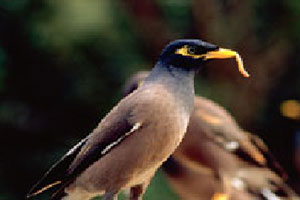Common Myna

Common (or Indian) myna are medium sized brown birds with a black head and yellow feet, eye-patch and bill. They occur naturally in open woodlands from Afghanistan through India to Indochina. The species was introduced into Australia in 1862 to control insects in Melbourne market gardens, through Sydney, and then to North Queensland to combat cane beetles.
Common myna was introduced to the Canberra region in 1968 where they have shown a distinct liking for urban backyards. While they also occur in ACT woodland reserves, their numbers are favourably in decline across such habitats. They are, however, well established in almost every Canberra suburb.
Common myna compete with native wildlife for food and nesting hollows. They are highly intelligent birds known to evict native species (including birds and mammals) from their nesting and roosting hollows, in some cases destroying eggs and chicks.
Management & Research
Despite their abundance, current evidence does not indicate that Common myna have a significant negative impact on endangered native bird species or agricultural production in the ACT.
The ACT Parks and Conservation Service collaborated with the Australian National University (ANU) in 2004 in a trial that determined whether Common myna could be successfully removed from urban areas of the ACT. The results of this trial suggested that, whilst trapping had some impact on myna numbers in the local vicinity of traps, it is not a practical method to eradicate or achieve a long-term reduction in myna numbers on a broad scale.
Living with Common myna
Common myna will eat dog and cat food left outside in the back yard, which can contribute to increasing Common myna numbers in urban areas. You can help to reduce Common myna in your suburb by ensuring they do not have access to these food sources.

